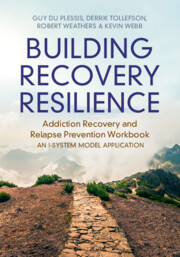 Building Recovery Resilience
Building Recovery Resilience Published online by Cambridge University Press: 28 May 2024
In the last chapter the authors provide an overview of all aspects of a Recovery Resilience Practice that will contribute towards a sustainable recovery-oriented lifestyle. In this chapter the reader will consolidate their Recovery Resilience Practice and see how to use it to support any recovery program or pathway. As highlighted throughout the workbook, the central aim of a Recovery Resilience Practice is to remove the hindrance that obstructs one’s capacity to access Recovery Capital and apply recovery skills as well as provide a practice that can help one deal moment by moment with stress, high-risk situation, triggers, or any troubling situations. In short, a Recovery Resilience Practice removes the hindrance to one’s innate resilience and capacity for flourishing and assists in achieving recovery and life goals. The last chapter provides an overview of how the workbook assists individuals in recovery to have greater self-awareness of their unhealthy and healthy coping styles and prompts them to evolve to a place of greater self-awareness so that they can make more informed decisions about their lives and efficaciously deal with life’s challenges.
To save this book to your Kindle, first ensure no-reply@cambridge.org is added to your Approved Personal Document E-mail List under your Personal Document Settings on the Manage Your Content and Devices page of your Amazon account. Then enter the ‘name’ part of your Kindle email address below. Find out more about saving to your Kindle.
Note you can select to save to either the @free.kindle.com or @kindle.com variations. ‘@free.kindle.com’ emails are free but can only be saved to your device when it is connected to wi-fi. ‘@kindle.com’ emails can be delivered even when you are not connected to wi-fi, but note that service fees apply.
Find out more about the Kindle Personal Document Service.
To save content items to your account, please confirm that you agree to abide by our usage policies. If this is the first time you use this feature, you will be asked to authorise Cambridge Core to connect with your account. Find out more about saving content to Dropbox.
To save content items to your account, please confirm that you agree to abide by our usage policies. If this is the first time you use this feature, you will be asked to authorise Cambridge Core to connect with your account. Find out more about saving content to Google Drive.